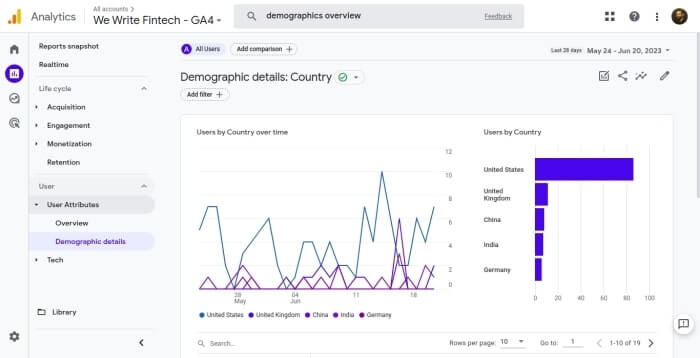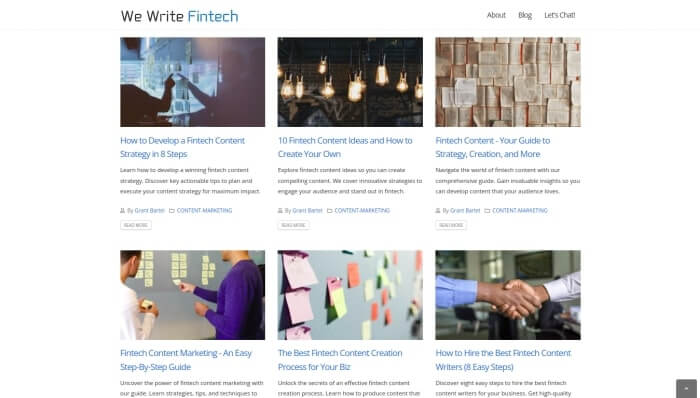Fintech Content - Your Guide to Strategy, Creation, and More


In today’s digital era, content has become the main way businesses connect with their audience and establish their expertise. In this article, we’ll explore the world of fintech content and its significance in the financial technology industry. We’ll begin by defining fintech content and understanding its role in content marketing strategies employed by fintech companies.
What Is Fintech Content?
Fintech content refers to creating and distributing informative and engaging materials focusing on the intersection of finance and technology. It encompasses a wide range of content formats and incorporates articles, videos, podcasts, infographics, and social media posts designed to educate and captivate the audience.
Fintech companies leverage content marketing strategies to position themselves as thought leaders, attract customers, and showcase the benefits of their innovative solutions. A well-executed fintech content strategy is vital for success in the highly competitive fintech landscape.
By developing a strategic approach to content creation, distribution, and promotion, fintech companies can effectively communicate their expertise, build brand awareness, and foster trust among their target audience.
A robust content strategy enables companies to consistently produce valuable content that addresses their audience’s specific needs, establishing them as authoritative voices within the industry.
A comprehensive fintech content marketing strategy involves understanding the target audience, conducting market research, and aligning content efforts with business objectives. By delivering compelling and relevant information through websites, blogs, and social media platforms, fintech companies can enhance their online presence.
The goal is to increase brand visibility and differentiate themselves from competitors.
What You Need to Know About the Fintech Industry
The fintech industry is a rapidly evolving landscape where technology and finance intersect to drive innovation and transform traditional financial services. Quality content helps educate customers on fintech solutions and builds credibility.
As fintech companies strive to stay ahead in this competitive market, having a robust content strategy is crucial for marketing teams to engage effectively with potential and prospective customers.
The central part of an optimal fintech content marketing strategy is establishing a brand with high-quality content. By developing engaging materials like articles, videos, and infographics, a fintech company can establish brand authority and position itself as an industry leader.
The fintech industry presents exciting opportunities for creating content that resonates with potential customers. Fintech companies can establish their brand authority and effectively engage with their target audience by focusing on high-quality content.
Leveraging influencer marketing, sharing customer stories, and addressing challenges is the name of the game.
A Guide to Fintech Content Strategy, Creation, Distribution, and Optimization
In the fast-paced fintech world, having a well-defined content strategy is crucial for businesses looking to make their mark, attract new audiences, and drive engagement.
This guide shows you how to allocate your resources, create compelling content, and optimize its distribution to become a thought leader.
Following the guide helps you connect with your targets and generate leads. Investing time and effort in these strategies will ensure that every dollar spent on content marketing makes a significant impact.
Define Your Fintech Content Marketing Strategy
To start, clearly define your goals and objectives for your fintech content marketing efforts. Are you aiming to increase brand awareness, drive website traffic, generate leads, or educate? Setting measurable goals will guide your content creation process and help you track the success of your campaigns.
Learn about your customer’s pain points. Identify your clients and customers to create accurate buyer personas. This knowledge will enable you to tailor your content to their specific needs, making it more engaging.
Conduct market research to learn your audience’s demographics, preferences, and behaviors. This allows you to:
-
Sort them into categories like age, income, occupation, and interests.
-
Develop detailed personas representing your ideal customers, including their goals, challenges, and motivations.
-
Use data and analytics to continuously refine and update your buyer personas as you gather more insights.

Research and Plan Your Fintech Content
Follow the latest developments in the fintech industry through market research. Identify trending topics, keywords, and areas of interest to inform your content strategy. Additionally, analyze your competitors’ content to identify gaps and potential customers.
-
Stay informed about the latest innovations in the fintech industry.
-
Analyze your competitors’ content marketing strategies, identify their strengths and weaknesses, and look for opportunities to differentiate your content.
-
Use keyword research tools to discover your audience’s desired keywords and topics.
-
Monitor social media platforms, industry forums, and online communities to identify trending topics and discussions.
Map out different content types. Fintech content marketing has to capture different consumers in different ways. It’s vital to use a broad-based strategy that leverages all assets and covers a wide array of content consumers.
5 Types of Content to Base Your Strategy On
-
Blog Posts and Articles: Create informative and engaging written content that addresses your audience’s needs and establishes your brand as an authority in the fintech space.
-
Videos: Produce educational and visually appealing videos that explain complex topics, showcase your products or services, and engage your audience.
-
Whitepapers and E-books: Develop in-depth resources that delve into specific fintech topics, offer valuable insights, and provide actionable advice for your audience.
-
Webinars and Online Events: Host live or pre-recorded webinars and online events to educate your audience, demonstrate thought leadership, and interact with participants in real-time. Invite influencers and thought leaders to discuss current topics of interest to clients.
-
Infographics and Visual Content: Present data, statistics, and complex information in a visually appealing, easy-to-understand format that drives engagement and increases sharing.
Remember, the choice of content types and formats should align with your audience’s preferences, the goals of your content marketing strategy, and the resources available to your marketing team. Regularly evaluate your content’s metrics to engage your audience.
Create Compelling Fintech Content for Your Target Audience
To effectively engage an audience in the fintech industry, you need your fintech content writers creating compelling content that resonates with their needs and interests is crucial. Here are the three building blocks for making captivating content.
1. Craft Engaging Blog Posts and Articles
Develop a blog strategy that focuses on providing valuable insights and information to foster customer acquisition. Write well-researched and informative articles that address emerging trends in the complex world of fintech.

Incorporate keywords strategically to optimize your content for search engines and attract organic traffic. Share your expertise, provide practical advice, and offer actionable solutions to help readers make informed financial decisions.
Additionally, consider creating content with engaging visuals, such as infographics and charts, to enhance your blog posts’ readability and visual appeal. How to guides and whitepapers establish you as an authority in the fintech industry.
2. Develop Comprehensive Guides and Whitepapers
Create content guides that delve into specific topics related to your service offerings. Provide in-depth insights, industry best practices, and actionable steps that help your audience navigate the complexities of financial technology.
Whitepapers, backed by published research and analysis, offer thought leadership and valuable information to your audience. Present your expertise, highlight trends, and offer recommendations to address challenges in the fintech business landscape.
3. Produce Informative Videos and Webinars
Videos and webinars are critical mediums that engage your audience and deliver valuable content. Create high-quality videos that simplify complex concepts, explain new technologies, and provide insights into the latest trends in the fintech industry.
You can showcase product demos, conduct interviews with industry experts, or share success stories of how your solutions have benefited businesses or individuals. Webinars allow you to interact directly with your audience.
Ensure your videos and webinars are well-produced, visually appealing, and offer helpful content that provides value to your audience.
Build Trust with New Audiences
By leveraging these content formats, you can position your fintech company as a trusted thought leader, foster engagement with customers, and establish a reputation for delivering high-quality and informative content in the fintech industry.
Remember to publish research-driven content regularly, keep up with industry trends, and consistently provide valuable insights to keep your audience engaged and informed.
Optimize Your Content for Maximum Reach
To ensure your fintech content reaches the right audience, conduct thorough keyword research to identify relevant keywords and phrases. Incorporate these keywords strategically throughout your content to improve its search engine optimization (SEO).
Focus on long-tail keywords specific to the fintech industry and align with your audience’s search intent. Optimize your company website’s on-page elements — including meta tags, headings, URLs, and image alt tags, to improve its visibility in search engine results.

Ensure your content is well-structured, easy to read, and includes internal and external links to authoritative sources. Pay attention to page loading speed and mobile responsiveness. They both contribute to a positive user experience and search engine rankings.
Off-page SEO involves building high-quality backlinks from reputable websites in the fintech industry. Engage in guest blogging and influencer collaborations. Participate in industry forums and discussions to establish your brand’s authority and credibility.
Encourage social sharing of your content and actively seek opportunities for external websites to link back to your valuable fintech content.
Amplify Your Content Using Social Media
Pinpoint the social media channels where your audience is, and engage with them there. LinkedIn and Twitter are particularly leveraged within the fintech industry, providing opportunities to connect with professionals, share insights, and promote your content.
Facebook and Instagram may also be valuable depending on your specific audience. Leverage user-generated content and customer stories to showcase the impact of your fintech solutions and foster trust among your audience.
Remember the five steps of social media engagement:
-
Craft compelling social media posts.
-
Find the right brand voice.
-
Use captivating visuals.
-
Include relevant hashtags.
-
Encourage social sharing and engagement.
Consider running targeted social media advertising campaigns to reach new clients and drive engagement. Utilize precise targeting based on demographics, interests, and behaviors to ensure your content reaches prospective customers. Monitor campaign performance and make data-driven optimizations to maximize the effectiveness of your social media ads.
How to Build Thought Leadership in the Fintech Industry
Publish informative and insightful content that showcases your expertise and thought leadership in the fintech industry.
Provide valuable tips, best practices, and actionable advice. Engage in industry discussions, comment on relevant blogs and articles, and actively participate in fintech events and conferences to enhance your brand’s visibility and reputation.
Collaborate with influencers and industry experts to amplify your content’s reach and gain credibility. Identify key influencers in the fintech world who have a solid following and align with your brand values.
Use guest blogging, interviews, or co-creation of content to leverage their expertise and tap into their user base. Develop long-form content such as whitepapers, e-books, and research reports that delve into complex topics and provide valuable insights.
Promote this content through various channels, including your website, social media platforms, and email marketing. Establish your reputation as the go-to resource for industry insights and analysis.
Measure the Success of Your Content’s Performance and Analyze It
Define specific KPIs that align with your content marketing goals, such as website traffic, engagement metrics, lead generation, and conversion rates. Google Analytics is good for measuring these metrics.

Tools like Google Analytics will allow you to:
-
Track age views, bounce rate, visitor time spent, and social media engagement.
-
Gain insights into which types of content resonate the most with your readers and adjust your content strategy accordingly.
-
Identify trends, patterns, and areas for improvement to optimize future content creation and distribution.
-
Use the data and insights gathered from your content metrics to make informed decisions and data-driven improvements.
-
Identify content that performs well and replicate its success by creating similar pieces. Identify gaps or areas of underperformance and adjust your content strategy to address them.
-
Continuously refine and optimize your digital marketing efforts based on data-driven insights to drive better results and get more leads.
Continuously Improve Your Content Marketing Efforts
Content marketing requires continuous improvement and adaptation. The technology changes in the fintech industry necessitate regular content audits.
Remember to assess the effectiveness of your existing content and identify opportunities for enhancement. Seek feedback from your audience and adapt your content strategy based on their preferences and pain points.
Final Thoughts
In today’s competitive fintech landscape, a well-executed content strategy can significantly impact customer engagement. Remember to define clear goals, conduct thorough research, create compelling content, amplify its reach through various channels, measure performance, and continuously refine your approach.
By consistently delivering high-quality, relevant content, your company will emerge as a trusted thought leader in the fintech industry and drive meaningful engagement with your audience. Incorporate these strategies into your fintech content marketing and adapt them to suit your company’s specific needs and goals to build a strong brand presence in the dynamic world of fintech.

